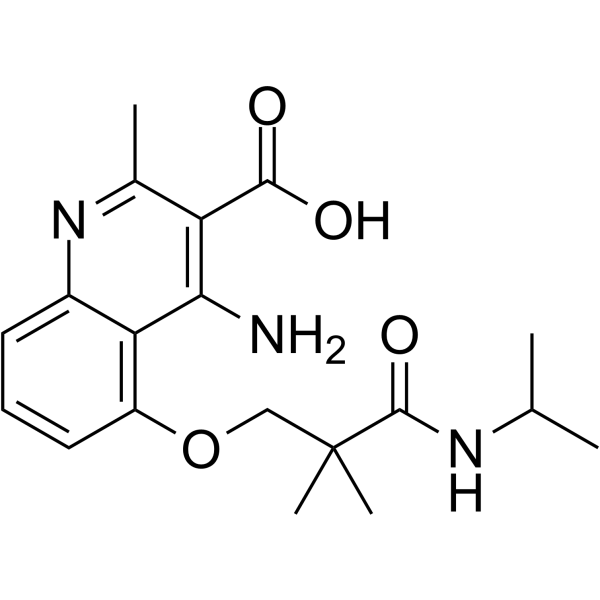1359963-68-0
| Name | FEMA4774 |
|---|---|
| Synonyms |
4-Amino-5-[3-(isopropylamino)-2,2-dimethyl-3-oxopropoxy]-2-methyl-3-quinolinecarboxylic acid
MFCD31916241 4-Amino-5-[2,2-dimethyl-3-[(1-methylethyl)amino]-3-oxopropoxy]-2-methyl-3-quinolinecarboxylic acid T66 BNJ C1 DVQ EZ GO1X1&1&VMY1&1 4-Amino-5-[3-(isopropylamino)-2,2-dimethyl-3-oxopropoxy]-2-methylquinoline-3-carboxylic acid 22211630 3-Quinolinecarboxylic acid, 4-amino-5-[2,2-dimethyl-3-[(1-methylethyl)amino]-3-oxopropoxy]-2-methyl- |
| Description | FEMA 4774 is a positive allosteric modulator of taste receptors T1R2 and T1R3, two subunits of the human sweet taste receptor. FEMA 4774 is also used as a sucrose sweetness enhancer[1]. |
|---|---|
| Related Catalog | |
| In Vitro | FEMA 4774 (0-50 μM) induces a dose-dependent decrease in the EC50 value of sucrose and significantly enhances the affinity of sucrose for its binding site with an α (effect of modulator on agonist affinity) value of 30 in the human sweet receptor cells[1]. |
| In Vivo | FEMA 4774 (S9632) (oral gavage, 500-2000 mg/kg) does not cause a dose-dependent increase in polychromatic erythrocytes and induces micronuclei formation at dose levels up to 2000 mg/kg in Swiss albino (CD-1) mice[2]. The pharmacokinetic parameters of FEMA 4774 (S9632) in Male and Female Sprague-Dawley Rats Route Day Dose (mg/kg) Sex Cmax (ng/mL)±SD Tmax (hr) t1/2 (hr) AUC0last(ng•hr/mL) AUC0last/dose(ng•hr/mL/mg/kg) %F iv 1 1.0 M 2036.7±281.9 0.03 0.19 330.6±58 330.6 - F 2625.8±679.9 0.03 0.27 411.9±116.3 411.9 - Oral gavage 1 10 M 12.9±3.2 0.25 1.21 17.9±2.3 1.79 0.54 F 34.0±3.9 0.25 1.17 49.2±7.8 4.92 1.19 30 M 90.0±23.9 0.33 0.88 90.8±11.0 3.03 0.92 F 62.4±25.9 0.42 1.06 95.0±20.4 3.17 0.77 100 M 147.2±86.3 0.33 0.71 176.2±73.8 1.76 0.53 F 268.5±90.7 0.25 0.99 341.1±81.0 3.41 0.83 Oral gavage 7 10 M 16.2±3.6 0.50 0.84 48.1±33.2 4.81 - F 32.7±9.7 0.33 1.17 58.9±25.4 5.89 - 30 M 74.5±16.2 0.33 0.94 86.0±8.7 2.87 - F 77.1±41.7 0.25 1.39 106.8±8.7 3.56 - 100 M 117.9±15.3 0.25 0.72 185.3±15.3 1.85 - F 189.7±79.5 0.25 0.89 278.9±79.0 2.79 - |
| References |
| Density | 1.2±0.1 g/cm3 |
|---|---|
| Boiling Point | 602.1±55.0 °C at 760 mmHg |
| Molecular Formula | C19H25N3O4 |
| Molecular Weight | 359.419 |
| Flash Point | 318.0±31.5 °C |
| Exact Mass | 359.184509 |
| LogP | 3.48 |
| Vapour Pressure | 0.0±1.8 mmHg at 25°C |
| Index of Refraction | 1.602 |
| Storage condition | -20°C |
